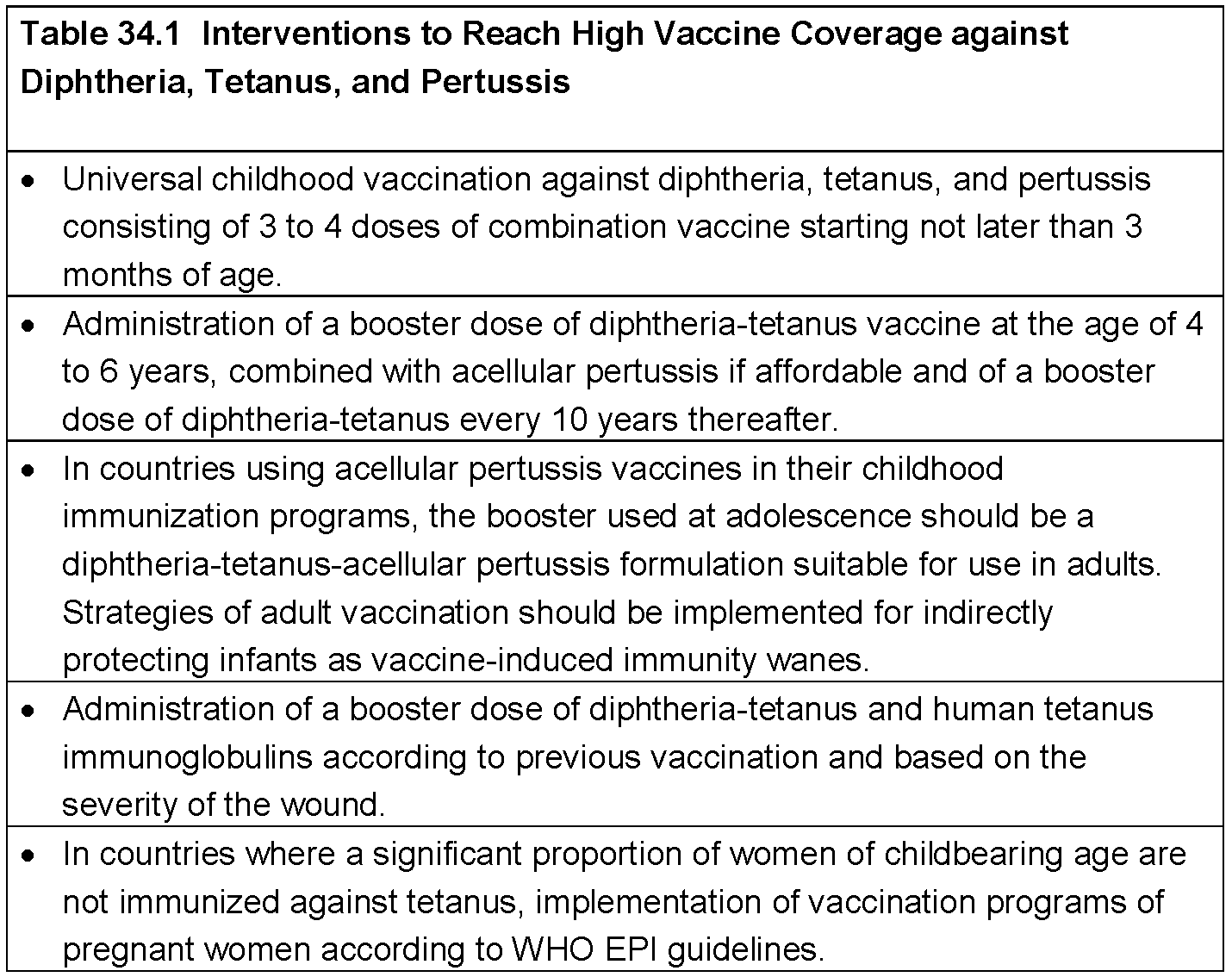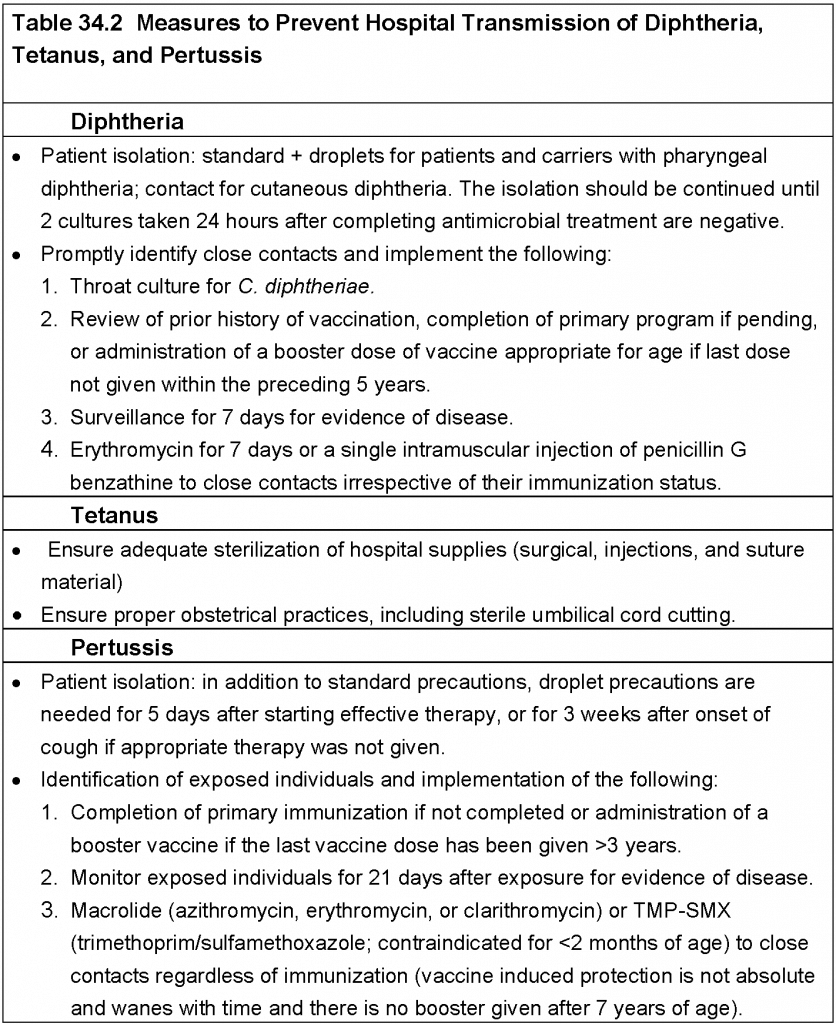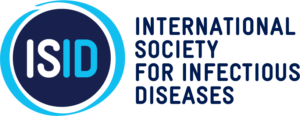GUIDE TO INFECTION CONTROL IN THE HEALTHCARE SETTING
DIPHTHERIA, TETANUS, PERTUSSIS
Authors: Jaffar A. Al-Tawfiq, MD
Chapter Editor: Ziad A. Memish, MD, FRCPC, FACP
Print PDF
KEY ISSUE
Active immunization of the general population is effective to control the transmission of diphtheria, tetanus, and pertussis infections in the community, and the possible risk of infection in the healthcare setting.
KNOWN FACTS
- Corynebacterium diphtheriae (causative agent of diphtheria) and Bordetella pertussis (causative agent of pertussis or whooping cough) are transmissible from person to person, whereas Clostridium tetani (causative agent of tetanus) is not.
- Transmission of diphtheriae occurs from person to person through droplets and close physical contact with secretions from the nose, throat, eye (pharyngeal diphtheria), or skin (cutaneous diphtheria) of patients or carriers.
- Transmission of pertussis occurs by close contact via aerosolized droplets from patients with disease. Infants <4 months are at highest risk of severe disease.
- Transmission of tetani occurs by introduction of tetanus spores through a contaminated wound. This is more common after natural disasters in developing countries where immunization coverage is quiet low. Tetanus spores can also be introduced via the umbilical cord during delivery, causing tetanus neonatorum, an important health problem in developing countries. In addition the spores can enter the body through unclean burn, surgery, and dental extraction. The site of entry is some times unknown and at the time of presentation could have healed.
- Diphtheria, tetanus, and pertussis are mainly community-acquired infections. The high immunization coverage obtained by immunization programs in industrialized countries and by the WHO EPI (Expanded Programme on Immunization) has considerably reduced the global burden of these diseases.
- Universal vaccination during infancy against these 3 illnesses is done using a combination vaccine.
- Diphtheria and tetanus vaccines consist of single purified antigens: diphtheria and tetanus toxoids. Diphtheria vaccines used for children until the age of 6 years contain 6.7 to 30 flocculation units (Lf) of toxoid, whereas a vaccine with a reduced amount of antigen (not more than 2 Lf) should be used for individuals older than 6 years.
- There are 2 types of pertussis vaccines: whole cell vaccine (Pwc) and acellular vaccines (aP). The oldest and most widely used is the Pwc vaccine. This vaccine is highly protective, although there are differences between preparations. Pwc vaccines are usually not administered after the age of 7 years. aP vaccines consist of 2 or 3 purified antigens. They are less reactogenic than Pwc vaccines and have demonstrated their protective efficacy in clinical trials. However the duration of protection is probably shorter than that afforded by Pwc preparations. Combination of aP vaccines with other vaccines recommended for infant immunization (diphtheria, tetanus, IPV/inactivated polio vaccine, Hib/Haemophilus influenzae type b, and HBV/Hepatitis B virus) exist. Acellular pertussis-based vaccines remain significantly more expensive than whole cell preparations.
- Long-term protection against diphtheria, tetanus, and pertussis by vaccination requires primary immunization followed by the administration of booster doses of these vaccines.
- aP vaccines for use in adolescents and adults are available.
- Older children and adults with mild or atypical disease are the source of contamination for infants, thus pertussis vaccination of adolescents and adults is recommended in an attempt to obtain longer term protection and to provide indirect protection to infants.
- A “cocoon strategy”, defined as protecting vulnerable patients from infectious diseases by vaccinating those in close contact with them, had been advocated as a strategy.
- Cocooning immunization does not provide infants with antibodies, thus it is important to have pregnant women receive the vaccine.
- Transmission of diphtheria and pertussis in the hospital setting, although very rare, can occur. An infected patient can be the source of diphtheria or pertussis transmission whereas contaminated surgical material has been reported as a possible cause of tetanus.
CONTROVERISAL ISSUES
- Rare severe neurological events leading to permanent brain damage occurring in infancy have been attributed to immunization with Pwc vaccine in the years 1970s, leading to the interruption of pertussis vaccination programs in some industrialized countries. This has been followed by a recrudescence of pertussis in these countries, thereby demonstrating the role of vaccination in controlling the disease. Whether these neurological events were only temporally related or caused by vaccination has been a source of controversy. One large case control study performed in England has not established a causal relationship between such neurological events and pertussis vaccination.
- Pa vaccines have been demonstrated to be effective in large clinical trials. However, in recent years, a recrudescence in the number of cases of pertussis has been reported in several countries where the Pa vaccines have replaced Pw vaccines in the immunization programs, warranting the use of booster doses in adolescence and adulthood.
- Pwc vaccines are widely used in countries with limited resources. In a number of industrialized countries, Pwc vaccines are still preferred on the basis of cost benefit evaluations and/or demonstrated long-term effectiveness.
SUGGESTED PRACTICE
- All interventions that allow reaching high vaccine coverage should be promoted (see Table 34.1). Vaccination schedules vary according to local practice; guidelines are proposed by WHO EPI.
- Diphtheria and pertussis are transmissible from person to person and thus adequate isolation precautions should be in place in hospitals to prevent hospital transmission.
- Tetanus is not transmissible from person to person, and thus the aim is to avoid rare cases of infections related to contaminated hospital material and maintaining adequate standard of care for wound management and obstetrical practice (see Table 34.2).
SUGGESTED PRACTICE IN UNDER-RESOURCED SETTINGS
- Pertussis infection rate is highest among unvaccinated children and the teens.
- Consideration should be given to vaccinate pregnant women in the second-trimester to increase neonatal antibodies.
- Improve childhood immunization for pertussis and diphtheria through EPI.
- Focus on proper delivery and training of individuals assessing the deliveries to prevent neonatal tetanus
- Control neonatal tetanus to <1 case/1000 live birth in each health district by having a high vaccine coverage of tetanus toxoid of pregnant women and proper neonatal cord handling.
- The World Health Organization continues to recommend the use of DTwP (diphtheria, tetanus, whole cell pertussis) in resource-poor countries.


SUMMARY
Corynebacterium diphtheria, the causative agent of diphtheria, and Bordetella pertussis (causative agent of pertussis or whooping cough) are transmissible from person to person, whereas Clostridium tetani (causative agent of tetanus) is not. Transmission of C. diphtheriae occurs from person to person through droplets and close physical contact with secretions from the nose, throat, eye (pharyngeal diphtheria), or skin (cutaneous diphtheria) of patients or carriers. Transmission of B. pertussis occurs by close contact via aerosolized droplets from patients with disease. Transmission of C. tetani occurs by introduction of tetanus spores through a contaminated wound. Universal vaccination during infancy against these 3 diseases is an excellent strategy for prevention.
REFERENCES
- Plotkin SA, Orenstein WA, Offit PA (Eds.). Vaccines. WB Saunders Company, 2008.
- Red Book. 2015 Report of theCommittee on Infectious Diseases (30th Edition). American Academy of Pediatrics. Kimberlin DW, Brady MT, Jackson MA, Long SS (Eds.).
- Last JM, Wallace RB (Eds.). Public Health and Preventive Medicine. Appleton and Lange, 2007.
- ACIP Recommended Immunization Schedules for Persons Aged 0 through 18 Years and Adults Aged 19 Years and Older — United States 2013. MMWR. Morb Mortal Wkly Rep. 2013; 62(01).
- Pertussis Vaccines: WHO Position Paper. WHO Wkly Epidemiol Rec. 2010; 85(40):385–400.
- Diphtheria Vaccine: WHO Position Paper. WHO Wkly Epidemiol Rec. 2017; 92(31):417–35.
- Tetanus Vaccines: WHO Position Paper. WHO Wkly Epidemiol Rec 2017; 92(6):53–76.
- Al-Tawfiq JA, AbuKhamsin A. Bordetella pertussis Infection in a Highly Vaccinated Population in Saudi Arabia, 1996-2004. J Infect. 2007; 55(3):249–53.
- World Health Organization. Pertussis Vaccines: WHO Position Paper, August 2015 —Recommendations. Vaccine. 2016; 34(12):1423–5.
- Global Health: Diseases, Programs, Systems and Policies. Third Edition. Edited by Michael Merson, Robert Black, and Anne Mills. Chapter 5, Infectious DIseases. Pertussis. P184. (https://books.google.com.sa/books?id=QUdHyfnYlHgC&pg=PA184&lpg=PA184&dq=pertussis+low+resource+countries+infection+control&source=bl&ots=LHoBvWCIsb&sig=i4zWt0UVwCNEql4tvOeBxKaBoA8&hl=en&sa=X&ved=0ahUKEwiOj_WF6s_YAhXMPZoKHT02CowQ6AEIYzAJ#v=onepage&q&f=false).
